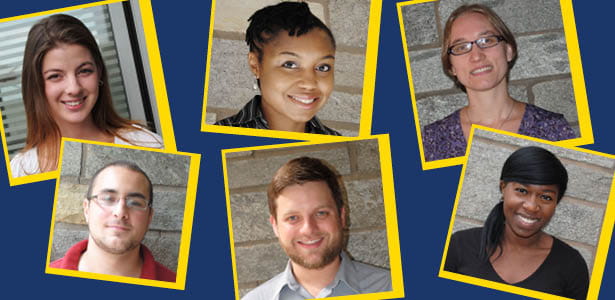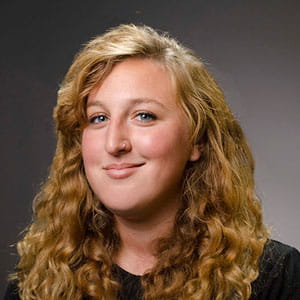Six Drexel Students Receive Fulbright Grants

- Mosquitoes' Bloodsucking Tubes Could Enable High-Definition 3D Printing
- Drexel Selects New, World-Class Life Sciences Building at 3201 Cuthbert Street for Medical Research Operations
- Breakthrough on Gene Therapy for Hereditary Spastic Paraplegia
- Drexel Environmental Collaboratory Releases Cross-Sector Findings on Severe Weather Recovery Challenges

A record-breaking six Drexel students were offered grants from the Fulbright US Student Program for study and research in 2013-14, the largest amount of grantees in Drexel history.
The candidates come from a wide spectrum of studies and intended areas of research.
"I'm excited that there's a wide range of applicants from different fields,” said Rona Buchalter, director of the Drexel Fellowships Office. “We've got someone doing creative arts therapy, we've got engineers, we've got a medical student, and we’ve got a public health student, so there's some really nice fields and schools being represented.”
The six accepted students are either working on their doctoral or master’s degrees and have experience in their respective fields. Originally, Drexel had five grantees, which was still the highest number of students offered the Fulbright scholarship in Drexel history, but mechanical engineering student Nicholaus Meyers, was offered a chance to study in Germany and work on the optimization of fracture fixation devices to better care for those with a bone fracture. He had previously been listed as an alternate.
“Each individual host country announces on its own schedule, starting in early March and going through as late as early June in some cases,” said Buchalter, who added that all of the students have heard even though some countries are still at the announcement stage.
Adefolaseyi “Seyi” Aderotoye aims to focus on the cultural and socioeconomic influence on pain management for sickle cell disease patients in Nigeria, where her parents are from. Currently in her second year at Drexel’s College of Medicine, she previously received the NIH Heart, Lung, Blood Summer Research Fellowship.
School of Public Health graduate student Lauren Forbes is the second candidate who will be working in Africa, but she will be located in Ethiopia. Forbes, who is working on her master’s in Public Health, previously worked on health care-related projects in The Gambia through Drexel’s weServe program in South Africa. She plans to use her experience to work with the Ethiopian Public Health Association to improve reproductive health services for adolescents in the Amhara region of Ethiopia. In addition to her studies, Forbes also spent time as a student representative to the Maternal and Child Health Working Group.
"I don't think we've ever had two people go to Africa in a single year, but we've never had more than a small number going anywhere," said Buchalter. “Two years ago, a student went to Senegal, and another Drexel Fulbright scholar had previously gone to Morocco before that.”
Elizabeth “Liesbet” Manders, is working on her doctoral degree in creative arts therapy from Drexel’s College of Nursing and Health Professions and will travel to Germany for her Fulbright. She plans to study the effect of dance/movement therapy on people with autism, something she has had previous professional experience with.
The other two Fulbright scholars are Nathan Taylor, a mechanical engineering pursuing a doctoral degree in Drexel’s College of Engineering, and Sarah Lightfoot Vidal, who is pursuing a master’s degree in materials science and engineering. Vidal plans on researching a polymer blend of Polyhydroxyalkanoates (PHA) for use in the medical field at CIPA’s Functional Polymer Department, in conjunction with the Polymers department at the Universidad de Concepción in Chile. Taylor will be located in South Korea at Kwangwoon University, where he hopes to use the university’s experience with plasma science to expand his expertise on water treatment techniques.
Drexel initially had twenty students successfully submit applications to the Fulbright US Student Program, 11 of which were selected as finalists by national screening committees composed of a panel of academics and diplomats who have knowledge of the specific host countries the students are applying to study in. The finalists were announced in January and then the country-specific committees for host countries made their final selection of who they offered the Fulbright scholarship to in April. According to Buchalter, Fulbright usually chooses twice the number of students for the number of spots available in a country.
In 2012, Drexel only had one Fulbright scholar, as compared to the four students the year before and the three students before that.
"Last year was a little bit of an aberration in terms of the proportion of our finalists who were offered awards,” she said.
However, she said she has noticed more students becoming interested in the Fulbright program in recent years, which translates to more students applying.
"I'm excited that Drexel students now know about Fulbright and realize they can do it and realize they're perfectly viable candidates,” said Buchalter. “It takes a lot of work to put together that application but it's absolutely possible.”
In This Article
Contact
Drexel News is produced by
University Marketing and Communications.
